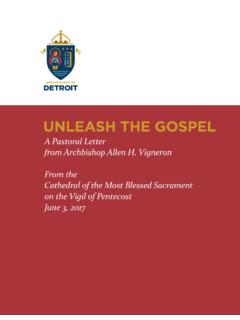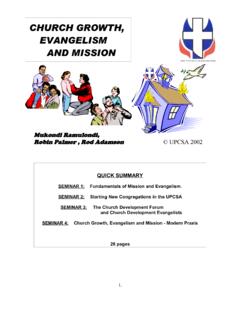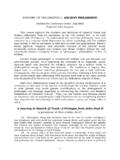Transcription of General Directory for Catechesis: Key Concepts
1 General Directory for catechesis : Key Concepts Jesus Christ, after his Resurrection, together with the Father, sent the Holy Spirit in order that He might accomplish from within the work of salvation and that He might animate His disciples to continue the mission to the whole world. He was the first and supreme evangelizer. He proclaimed the Kingdom of God as the urgent and definitive intervention of God in history, and defined this proclamation the Gospel , the Good News . To this Gospel, Jesus devoted his entire earthly life: He made known the joy of belonging to the Kingdom, its demands, its magna carta, the mysteries which it embraces, the life of fraternal charity of those who enter it and its future fulfillment.
2 (GDC 34) GD 1 Table of Contents General Directory for catechesis : Key Concepts Revelation GD-3 Conversion and Faith GD-4 The Sacraments of Initiation GD-5 Evangelization GD-6 Evangelization and catechesis GD-7 Ministry of the Word and
3 catechesis GD-8 catechesis GD-10 Role of the Parish Community in catechesis : GD-11 Six Fundamental Tasks of catechesis GD-11 The Meaning of Inculturation in the General Directory GD-13 What Is Inculturation? GD-13 Who Does the Work of Inculturation?
4 GD-14 What Is the Role of catechesis in Inculturation? GD-15 What are the Agents which catechesis Uses to Effect Inculturation? GD-17 What is the Role of Language and Media in Inculturation? GD-18 Where is Inculturation Directed? GD-19 GD 2 Revelation God truly reveals Himself as one who desires to communicate Himself, making the human person a participant in His divine nature. In this way God accomplishes His plan of love. Fully revealed in Jesus Christ and realized by the power of the Holy Spirit, the providential plan of the Father implies: o the Revelation of God, of His innermost truth, and of the true vocation and dignity of the human person; o the offer of salvation to all, as a gift of God s grace and mercy, a gift which brings freedom from evil, sin and death; o the definite call to gather into the family of God all of His scattered children.
5 (GDC 37) God uses a pedagogy to reveal Himself to the human person: He uses human events and words to communicate His plan. (GDC 38) God revealed Himself progressively through the prophets and through salvific events, until He brought to completion His self-revelation by sending His own Son. Jesus is indeed the Father s one, perfect and unsurpassable Word. (GDC 40) GD 3 Conversion and Faith Christian faith is, above all, conversion to Jesus Christ, full and sincere adherence to His person and the decision to walk in His footsteps. Faith is a personal encounter with Jesus Christ, making of oneself a disciple of Jesus. This demands a permanent commitment to think like Him, to judge like Him and to live as He lived.
6 In this way the believer unites himself to the community of disciples and appropriates the faith of the Church. (GDC 53) This Yes to Jesus Christ, who is the fullness of the revelation of the Father, is twofold: a trustful abandonment to God and a loving assent to all that God has revealed to us. This is possible only by means of the action of the Holy Spirit. (GDC 54) Faith involves a metanoia, a change of life, a profound transformation of mind and heart. Faith and conversion arise from the heart, that depth of the human person which involves all that the person is. By meeting Jesus Christ and by adhering to Him the human being sees all of his deepest aspirations completely fulfilled. He finds what he has always been seeking and finds it superabundantly.
7 Faith is a gift from God. It can only be born as a completely free response to the promptings of the Holy Spirit who moves the heart and turns it toward God, and who makes it easy to accept and believe the truth. (GDC 55) Faith is destined to grow in the hearts of believers. Adhering to Jesus Christ sets in motion a process of continuing conversion which goes on for the whole of one s lifetime. (GDC 56) GD 4 The Sacraments of Initiation Faith, moved by divine grace and cultivated by the action of the Church, undergoes a process of maturation. catechesis , which is at the service of this growth, is also a gradual activity. The gradual nature of catechesis is inspired by the stages of the great catechumenal tradition of the Church.
8 In the baptismal catechumenate, formation is articulated in four stages: the pre-catechumenate: the locus of the first evangelization leading to conversion, where the kerygma of the primary proclamation is explained, the catechumenate: the context of integral catechesis beginning with the handing on of the Gospels , the time of purification and illumination: a more intense preparation for the sacraments of initiation, including the handing on of the Creed, and the handing on of the Lord s Prayer , the time of mystagogy: the experience of the sacraments and entry into the community. (GDC 88) There is a fundamental difference between pre-baptismal catechesis and post-baptismal catechesis .
9 However, some elements of the pre-baptismal catechumenate must inspire post-baptismal catechesis . The pre-baptismal catechumenate: o constantly reminds the whole Church of the fundamental importance of initiation and the basic factors which constitute it: catechesis and the sacraments of Baptism, Confirmation and Eucharist; o is the responsibility of the entire Christian community and thus increases awareness of the importance of every form of faith-education that the Church offers; o is completely permeated by the mystery of Christ s Passover; thus all catechesis must be inspired by the Paschal Mystery; o is an initial locus of inculturation since the Church receives catechumens integrally, together with their cultural ties.
10 All catechetical activity incorporates into the catholicity of the Church, authentic seeds of the word scattered through nations and individuals. o Is a process of formation and a school of the faith whose catechesis is characterized by: comprehensiveness and integrity of formation, gradual character expressed in definite stages, meaningful rites, symbols, biblical and liturgical signs, constant references to the Christian community. (GDC 90 and 91) GD 5 Evangelization The Church exists in order to evangelize, to carry forth the Good News to every sector of the human race so that by its strength the Good News may enter into the hearts of human beings and renew the human race. (GDC 46) Evangelization is the process by which the Church, moved by the Spirit, proclaims and spreads the Gospel throughout the entire world.








